5投资学第五章习题答案
投资学精要(博迪)(第五版)习题答案英文版chapter5综述
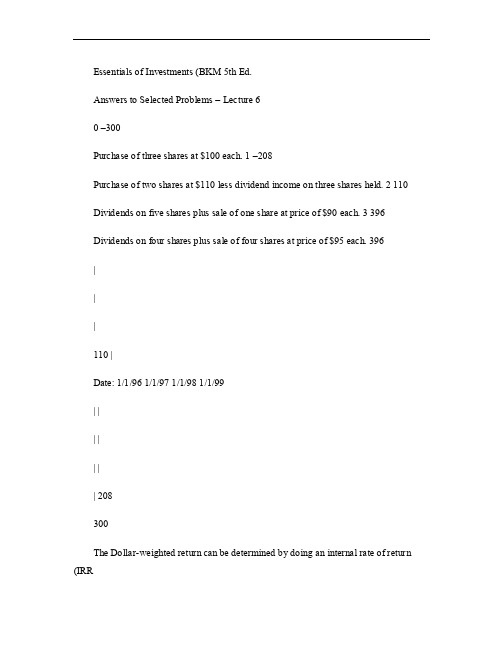
Essentials of Investments (BKM 5th Ed.Answers to Selected Problems – Lecture 60 –300Purchase of three shares at $100 each. 1 –208Purchase of two shares at $110 less dividend income on three shares held. 2 110 Dividends on five shares plus sale of one share at price of $90 each. 3 396Dividends on four shares plus sale of four shares at price of $95 each. 396|||110 |Date: 1/1/96 1/1/97 1/1/98 1/1/99| || || || 208300The Dollar-weighted return can be determined by doing an internal rate of return (IRRcalculation. In other words, set the present value of the outflows equal to the presentvalue of the inflows (or the net present value to zero: %1661. 0001661. 01(396 1(110 1(208300321−=−=+++=++R R R3. b.5. We need to distinguish between timing and selection abilities. The intercept of the scatterdiagram is a measure of stock selection ability. If the manager tends to have a positive excess return even when the market’s performance is merely ‘neutral’ (i.e., has zero excess return, then we conclude that the manager has on average made good stock picks – stock selection must be the source of the positive excess returns.Timing ability is indicated by curvature in the plotted line. Lines that become steeper as you move to the right of the graph show good timing ability. An upward curvedrelationship indicates that the portfolio was more sensitive to market moves when the market was doing well and less sensitive to market moves when the market was doingpoorly -- this indicates good market timing skill. A downward curvature would indicate poor market timing skill.We can therefore classify performance ability for the four managers as follows:a. Bad Goodb. Good Goodc. Good Badd. Bad Bad9. The manager’s alpha is:10 - [6 + 0.5(14-6] = 010. a α(A = 24 - [12 + 1.0(21-12] = 3.0%α(B = 30 - [12 + 1.5(21-12] = 4.5%T(A = (24 - 12/1 = 12T(B = (30-12/1.5 = 12As an addition to a passive diversified portfolio, both A and B are candidates because they both have positive alphas.b (i The funds may have been trying to time the market. In that case, the SCL of the funds may be non-linear (curved.(ii One year’s worth of data is too small a sample to make clear conclusions.(iii The funds may have significantly different levels of diversification. If both have the same risk-adjusted return, the fund with the less diversified portfolio has a higher exposure to risk because of its higher firm-specific risk. Since the above measure adjusts only for systematic risk, it does not tell the entire story.11. a Indeed, the one year results were terrible, but one year is a short time period from whichto make clear conclusions. Also, the Board instructed the manager to give priority to long-term results.b The sample pension funds had a much larger share in equities compared to Alpine’s. Equities performed much better than bonds. Also, Alpine was told to hold down risk investing at most 25% in equities. Alpine should not be held responsible for an asset allocation policy dictated by the client.c Alpine’s alpha measures its risk-adjusted performance compared to the market’s:α = 13.3 - [7.5 + 0.9(13.8 - 7.5] = 0.13%, which is actually above zero!d Note that the last five years, especially the last one, have been bad for bonds – and Alpine was encouraged to hold bonds. Within this asset class, Alpine did much better than the index funds. Alpine’s performance within each asset class has been superior on a risk-adjusted basis. Its disappointing performance overall was due to a heavy asset allocation weighting toward bonds, which was the Board’s –not Alpine’s – choice.e A trustee may not care about the time-weighted return, but that return is moreindicative of the manager’s performance. After all, the manager has no control over the cash inflow of the fund.。
投资学课后练习答案(贺显南版)
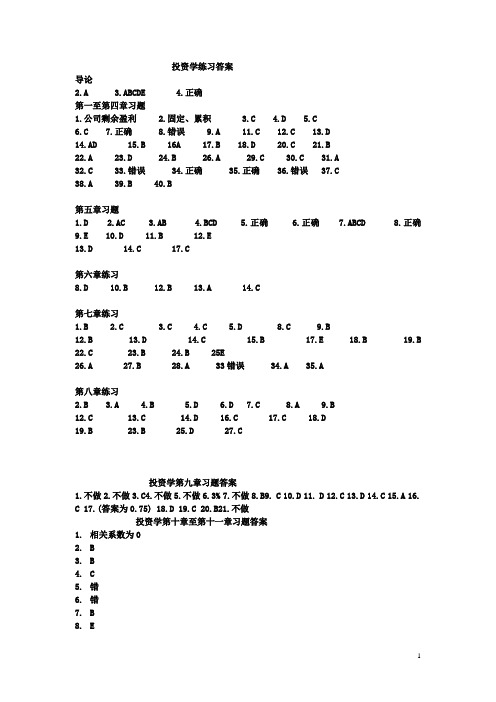
投资学练习答案导论2.A3.ABCDE4.正确第一至第四章习题1.公司剩余盈利2.固定、累积3.C4.D5.C6.C7.正确8.错误9.A 11.C 12.C 13.D14.AD 15.B 16A 17.B 18.D 20.C 21.B22.A 23.D 24.B 26.A 29.C 30.C 31.A32.C 33.错误 34.正确 35.正确 36.错误 37.C38.A 39.B 40.B第五章习题1.D2.AC3.AB4.BCD5.正确6.正确7.ABCD8.正确9.E 10.D 11.B 12.E13.D 14.C 17.C第六章练习8.D 10.B 12.B 13.A 14.C第七章练习1.B2.C3.C4.C5.D 8.C 9.B12.B 13.D 14.C 15.B 17.E 18.B 19.B 22.C 23.B 24.B 25E26.A 27.B 28.A 33错误 34.A 35.A第八章练习2.B3.A4.B5.D6.D7.C8.A9.B12.C 13.C 14.D 16.C 17.C 18.D19.B 23.B 25.D 27.C投资学第九章习题答案1.不做2.不做3.C4.不做5.不做6.3%7.不做8.B9. C 10.D 11. D 12.C 13.D 14.C 15.A 16.C 17.(答案为0.75) 18.D 19.C 20.B21.不做投资学第十章至第十一章习题答案1.相关系数为02. B3. B4. C5.错6.错7. B8. E9. A10.对11.D投资学第十二章至第十三章习题答案1.不做2.高于票面值因为10%大于8%3.具体看课本公式(老师只是讲公式没有给出确切得答案)4.贴现贴现率5.反方向6.C7.C8.对9.对10.不做11.折价平价溢价12.不做13.不做14.不做15.A16.C17.C18.具体看书本323页19.具体看课本325页20.看课本319至32021.不做22.不做第十四章至十五章习题答案1.先行同步滞后2.不做3.开拓拓展成熟衰落4.资产负责表损益表现金流量表5. C6.宏观分析行业分析公司分析7. A8. B9. A10.D11.D12.A13.A14.对15.对十七章注意事项: 注意技术分析得三大假设假设1. 市场行为涵盖一切信息假设2.价格沿趋势运动假设3.历史会重演。
投资学课后习题与答案(博迪)_第6版

投资学习题第一篇投资学课后习题与答案乮博迪乯_第6版 由flyesun 从网络下载丆版权归原作者所有。
1. 假设你发现一只装有1 00亿美元的宝箱。
a. 这是实物资产还是金融资产?b. 社会财富会因此而增加吗?c. 你会更富有吗?d. 你能解释你回答b 、c 时的矛盾吗?有没有人因为这个发现而受损呢?2. Lanni Products 是一家新兴的计算机软件开发公司,它现有计算机设备价值30 000美元,以及由L a n n i 的所有者提供的20 000美元现金。
在下面的交易中,指明交易涉及的实物资产或(和)金融资产。
在交易过程中有金融资产的产生或损失吗?a. Lanni 公司向银行贷款。
它共获得50 000美元的现金,并且签发了一张票据保证3年内还款。
b. Lanni 公司使用这笔现金和它自有的20 000美元为其一新的财务计划软件开发提供融资。
c. L a n n i 公司将此软件产品卖给微软公司( M i c r o s o f t ),微软以它的品牌供应给公众,L a n n i 公司获得微软的股票1 500股作为报酬。
d. Lanni 公司以每股80美元的价格卖出微软的股票,并用所获部分资金偿还贷款。
3. 重新考虑第2题中的Lanni Products 公司。
a. 在它刚获得贷款时处理其资产负债表,它的实物资产占总资产的比率为多少?b. 在L a n n i 用70 000美元开发新产品后,处理资产负债表,实物资产占总资产比例又是多少?c. 在收到微软股票后的资产负债表中,实物资产占总资产的比例是多少?4. 检察金融机构的资产负债表,有形资产占总资产的比率为多少?对非金融公司这一比率又如何?为什么会有这样的差异?5. 20世纪6 0年代,美国政府对海外投资者所获得的在美国出售的债券的利息征收 3 0%预扣税(这项税收现已被取消),这项措施和与此同时欧洲债券市场(美国公司在海外发行以美元计值的债券的市场)的成长有何关系?6. 见图1 -7,它显示了美国黄金证券的发行。
金德环《投资学》课后习题答案
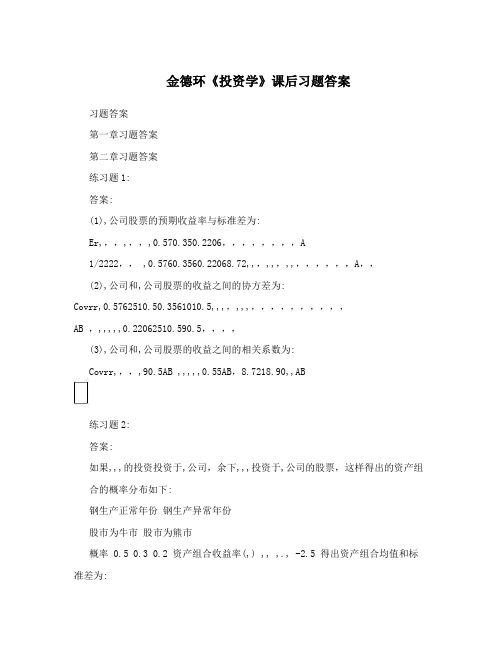
金德环《投资学》课后习题答案习题答案第一章习题答案第二章习题答案练习题1:答案:(1),公司股票的预期收益率与标准差为:Er,,,,,,,0.570.350.2206,,,,,,,,A1/2222,, ,0.5760.3560.22068.72,,,,,,,,,,,,,,A,,(2),公司和,公司股票的收益之间的协方差为:Covrr,0.5762510.50.3561010.5,,,,,,,,,,,,,,,,,AB ,,,,,,0.22062510.590.5,,,,(3),公司和,公司股票的收益之间的相关系数为:Covrr,,,,90.5AB ,,,,,0.55AB,8.7218.90,,AB练习题2:答案:如果,,,的投资投资于,公司,余下,,,投资于,公司的股票,这样得出的资产组合的概率分布如下:钢生产正常年份钢生产异常年份股市为牛市股市为熊市概率 0.5 0.3 0.2 资产组合收益率(,) ,, ,., -2.5 得出资产组合均值和标准差为:Er=0.516+0.32.5+0.2-2.5=8.25,,,,,,,,,,组合1/22222,, ,=0.516-8.25+0.32.5-8.25+0.2-2.5-8.25+0.2-2.5-8.25=7.94,,,,,,,,组合,,1/22222,=0.518.9+0.58.72+20.50.5-90.5=7.94,,,,,,,,,,,,,,,组合,,练习题3:答案:尽管黄金投资独立看来似有股市控制,黄金仍然可以在一个分散化的资产组合中起作用。
因为黄金与股市收益的相关性很小,股票投资者可以通过将其部分资金投资于黄金来分散其资产组合的风险。
练习题4:答案:通过计算两个项目的变异系数来进行比较:0.075 CV==1.88A0.040.09 CV==0.9B0.1考虑到相对离散程度,投资项目B更有利。
练习题5:答案:R(1)回归方程解释能力到底如何的一种测度方法式看的总方差中可被方程解释的方差所it2,占的比例。
西财《证券投资学》教学资料包 课后习题答案 第五章
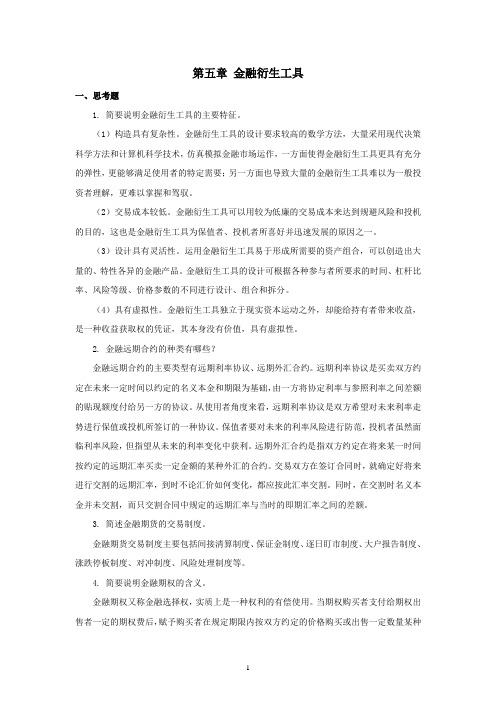
第五章金融衍生工具一、思考题1. 简要说明金融衍生工具的主要特征。
(1)构造具有复杂性。
金融衍生工具的设计要求较高的数学方法,大量采用现代决策科学方法和计算机科学技术,仿真模拟金融市场运作,一方面使得金融衍生工具更具有充分的弹性,更能够满足使用者的特定需要;另一方面也导致大量的金融衍生工具难以为一般投资者理解,更难以掌握和驾驭。
(2)交易成本较低。
金融衍生工具可以用较为低廉的交易成本来达到规避风险和投机的目的,这也是金融衍生工具为保值者、投机者所喜好并迅速发展的原因之一。
(3)设计具有灵活性。
运用金融衍生工具易于形成所需要的资产组合,可以创造出大量的、特性各异的金融产品。
金融衍生工具的设计可根据各种参与者所要求的时间、杠杆比率、风险等级、价格参数的不同进行设计、组合和拆分。
(4)具有虚拟性。
金融衍生工具独立于现实资本运动之外,却能给持有者带来收益,是一种收益获取权的凭证,其本身没有价值,具有虚拟性。
2. 金融远期合约的种类有哪些?金融远期合约的主要类型有远期利率协议、远期外汇合约。
远期利率协议是买卖双方约定在未来一定时间以约定的名义本金和期限为基础,由一方将协定利率与参照利率之间差额的贴现额度付给另一方的协议。
从使用者角度来看,远期利率协议是双方希望对未来利率走势进行保值或投机所签订的一种协议。
保值者要对未来的利率风险进行防范,投机者虽然面临利率风险,但指望从未来的利率变化中获利。
远期外汇合约是指双方约定在将来某一时间按约定的远期汇率买卖一定金额的某种外汇的合约。
交易双方在签订合同时,就确定好将来进行交割的远期汇率,到时不论汇价如何变化,都应按此汇率交割。
同时,在交割时名义本金并未交割,而只交割合同中规定的远期汇率与当时的即期汇率之间的差额。
3. 简述金融期货的交易制度。
金融期货交易制度主要包括间接清算制度、保证金制度、逐日盯市制度、大户报告制度、涨跌停板制度、对冲制度、风险处理制度等。
4. 简要说明金融期权的含义。
西财《投资学》教学资料包 课后习题答案 第五章

第五章证券投资工具一、思考题1.普通股票的权益有哪些?它和优先股票的区别是什么?(1)普通股股东享有的权利。
普通股股票持有者按其所持有股份的比例享有以下几种基本权利:①公司决策参与权。
普通股股东有权参与股东大会,并有建议权、表决权和选举权,也可以委托他人代表其行使股东权利。
②利润分配权。
普通股股东有权从公司利润分配中得到股息。
普通股的股息是不固定的,由公司的赢利状况及其分配政策决定。
普通股股东必须在优先股股东取得固定股息之后,才有权享受股息分配权。
③优先认股权。
如果公司需要扩张而增发普通股股票时,现有普通股股东有权按其持股比例,以低于市价的特定价格优先购买一定数量的新发行股票,从而保持其对企业所有权的原有比例。
④剩余资产分配权。
当公司破产或清算时,若公司的资产在偿还欠债后还有剩余,其剩余部分按先优先股股东、后普通股股东的顺序进行分配。
(2)优先股股东享有的权利。
优先股是相对于普通股而言的,主要是指在利润分配及剩余财产分配的权利方面优先于普通股。
优先股股东享有以下两种权利:①在公司分配赢利时,持有优先股的股东比持有普通股的股东优先参与分配,而且享受固定数额的股息,即优先股的股息率都是固定的(普通股的股息却不固定)。
分配股数视公司赢利情况而定,利多多分,利少少分,无利不分,上不封顶,下不保底。
②在公司解散,分配剩余财产时,优先股股东先于普通股股东参与分配。
2.试述我国的股权结构及其问题。
我国的股权结构包括国有股、法人股、社会公众股和外资股。
我国股权结构存在股权分置现象。
所谓股权分置,是指上市公司股东所持向社会公开发行的股份在证券交易所上市交易,称为流通股,而公开发行前股份暂不上市交易,称为非流通股。
这种同一上市公司股份分为流通股和非流通股的股权分置状况,为中国内地证券市场所独有。
3.什么是债券?它的特征和收益有哪些?按债券发行主体及债券形态的不同分类,债券有哪些类型?债券是国家政府、金融机构、企业等机构直接向社会借债时,向投资者发行,承诺按规定利率支付利息,并按约定条件偿还本金的债权债务凭证。
《投资学(第6版)》课后习题参考解答.docx
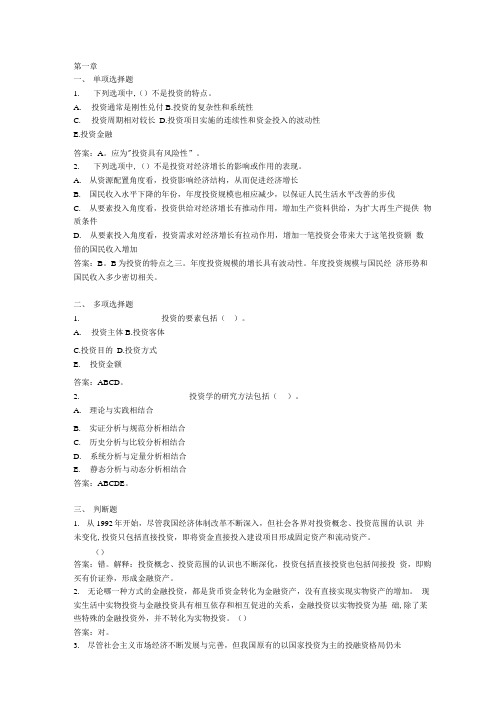
第一章一、单项选择题1.下列选项中,()不是投资的特点。
A.投资通常是刚性兑付B.投资的复杂性和系统性C.投资周期相对较长D.投资项目实施的连续性和资金投入的波动性E.投资金融答案:A。
应为"投资具有风险性”。
2.下列选项中,()不是投资对经济增长的影响或作用的表现。
A.从资源配置角度看,投资影响经济结构,从而促进经济增长B.国民收入水平下降的年份,年度投资规模也相应减少,以保证人民生活水平改善的步伐C.从要素投入角度看,投资供给对经济增长有推动作用,增加生产资料供给,为扩大再生产提供物质条件D.从要素投入角度看,投资需求对经济增长有拉动作用,增加一笔投资会带来大于这笔投资额数倍的国民收入增加答案:B。
B为投资的特点之三。
年度投资规模的增长具有波动性。
年度投资规模与国民经济形势和国民收入多少密切相关。
二、多项选择题1.投资的要素包括()。
A.投资主体B.投资客体C.投资目的D.投资方式E.投资金额答案:ABCD。
2.投资学的研究方法包括()。
A.理论与实践相结合B.实证分析与规范分析相结合C.历史分析与比较分析相结合D.系统分析与定量分析相结合E.静态分析与动态分析相结合答案:ABCDE。
三、判断题1.从1992年开始,尽管我国经济体制改革不断深入,但社会各界对投资概念、投资范围的认识并未变化,投资只包括直接投资,即将资金直接投入建设项目形成固定资产和流动资产。
()答案:错。
解释:投资概念、投资范围的认识也不断深化,投资包括直接投资也包括间接投资,即购买有价证券,形成金融资产。
2.无论哪一种方式的金融投资,都是货币资金转化为金融资产,没有直接实现实物资产的增加。
现实生活中实物投资与金融投资具有相互依存和相互促进的关系,金融投资以实物投资为基础,除了某些特殊的金融投资外,并不转化为实物投资。
()答案:对。
3.尽管社会主义市场经济不断发展与完善,但我国原有的以国家投资为主的投融资格局仍未被打破。
张元萍主编《投资学》课后习题答案
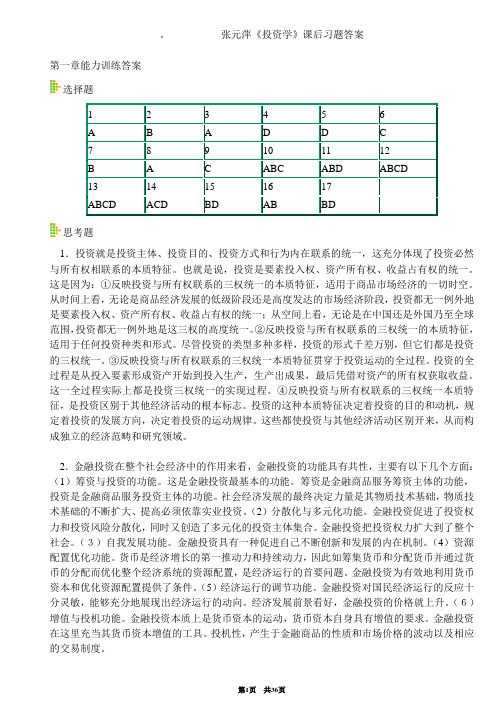
张元萍《投资学》课后习题答案第一章能力训练答案选择题1 2 3 4 5 6A B A D D C7 8 9 10 11 12B AC ABC ABD ABCD13 14 15 16 17ABCD ACD BD AB BD思考题1.投资就是投资主体、投资目的、投资方式和行为内在联系的统一,这充分体现了投资必然与所有权相联系的本质特征。
也就是说,投资是要素投入权、资产所有权、收益占有权的统一。
这是因为:①反映投资与所有权联系的三权统一的本质特征,适用于商品市场经济的一切时空。
从时间上看,无论是商品经济发展的低级阶段还是高度发达的市场经济阶段,投资都无一例外地是要素投入权、资产所有权、收益占有权的统一;从空间上看,无论是在中国还是外国乃至全球范围,投资都无一例外地是这三权的高度统一。
②反映投资与所有权联系的三权统一的本质特征,适用于任何投资种类和形式。
尽管投资的类型多种多样,投资的形式千差万别,但它们都是投资的三权统一。
③反映投资与所有权联系的三权统一本质特征贯穿于投资运动的全过程。
投资的全过程是从投入要素形成资产开始到投入生产,生产出成果,最后凭借对资产的所有权获取收益。
这一全过程实际上都是投资三权统一的实现过程。
④反映投资与所有权联系的三权统一本质特征,是投资区别于其他经济活动的根本标志。
投资的这种本质特征决定着投资的目的和动机,规定着投资的发展方向,决定着投资的运动规律。
这些都使投资与其他经济活动区别开来,从而构成独立的经济范畴和研究领域。
2.金融投资在整个社会经济中的作用来看,金融投资的功能具有共性,主要有以下几个方面:(1)筹资与投资的功能。
这是金融投资最基本的功能。
筹资是金融商品服务筹资主体的功能,投资是金融商品服务投资主体的功能。
社会经济发展的最终决定力量是其物质技术基础,物质技术基础的不断扩大、提高必须依靠实业投资。
(2)分散化与多元化功能。
金融投资促进了投资权力和投资风险分散化,同时又创造了多元化的投资主体集合。
投资学习题习题及答案

第一章投资环境1.假设你发现一只装有100亿美元的宝箱。
a.这是实物资产还是金融资产?b.社会财富会因此而增加吗?c.你会更富有吗?d.你能解释你回答b、c时的矛盾吗?有没有人因为这个发现而受损呢?a. 现金是金融资产,因为它是政府的债务。
b. 不对。
现金并不能直接增加经济的生产能力。
c. 是。
你可以比以前买入更多的产品和服务。
d. 如果经济已经是按其最大能力运行了,现在你要用这1 0 0亿美元使购买力有一额外增加,则你所增加的购买商品的能力必须以其他人购买力的下降为代价,因此,经济中其他人会因为你的发现而受损。
nni Products 是一家新兴的计算机软件开发公司,它现有计算机设备价值30000美元,以及由Lanni的所有者提供的20000美元现金。
在下面地交易中,指明交易涉及的实物资产或(和)金融资产。
在交易过程中有金融资产的产生或损失吗?nni公司向银行贷款。
它共获得50000美元的现金,并且签发了一张票据保证3年内还款。
nni公司使用这笔现金和它自有的20000美元为其一新的财务计划软件开发提供融资。
nni公司将此软件产品卖给微软公司(Microsoft),微软以它的品牌供应给公众,Lanni公司获得微软的股票1500股作为报酬。
nni公司以每股80元的价格卖出微软的股票,并用所获部分资金还贷款。
a. 银行贷款是L a n n i公司的金融债务;相反的,L a n n i的借据是银行的金融资产。
L a n n i获得的现金是金融资产,新产生的金融资产是Lanni 公司签发的票据(即公司对银行的借据)。
b. L a n n i公司将其金融资产(现金)转拨给其软件开发商,作为回报,它将获得一项真实资产,即软件成品。
没有任何金融资产产生或消失;现金只不过是简单地从一方转移给了另一方。
c. L a n n i公司将其真实资产(软件)提供给微软公司以获得一项金融资产—微软的股票。
由于微软公司是通过发行新股来向L a n n i支付的,这就意味着新的金融资产的产生。
投资学习题解答

D
24
第五章 无风险证券的投资价值
• 补充5: • 六个月期国库券的即期利率(年利率)为4%,一年期国库券的即期利
率为5%,问六个月后隐含的六个月远期利率是多少? • 解:利率是年利,但是支付方式是半年一次。因此,一年期债券每期
的即期利率为2.5%,而6个月债券则是2%。半年的远期利率为: • 1+f =1.025*1.025/1.02=1.03 • 这意味着远期利率是3%/半年,或者6%/年。
第五章 无风险证券的投资价值
• 4.某投资者2002年8月1日购入2005年8月1日到期偿还的面值100元的贴现债,期望报酬率 为8%,该债券在购入日的价值评估为多少?
D
19
第五章 无风险证券的投资价值
• 解:
V 0(1 F r)n (1 18% 03 0)7.9 38
D
20
第五章 无风险证券的投资价值
D
5
第四章 证券市场及期运行
• 解: • 5000+6000+8000+4000+7000=30000
n
Pa
WiPi
i1 n
Wi
1 (500014.84600027.10 30000
i1
800016.79400011.2570008.55)15.866
D
6
第四章 证券市场及期运行
• 5.现假定题3中五只股票基期的收盘价分别为8元、16元、9元、7元和6元,请分别用平均 法、综合法和加权综合法计算股价指数。
D
7
第四章 证券市场及期运行
• 解:(1)平均法
g1
1 n ni1
P1i 10 01( 8 16 9
《投资学》每章习题_以及答案

《投资学》习题第1章投资概述一、填空题1、投资所形成的资本可分为和。
2、资本是具有保值或增值功能的。
3、按照资本存在形态不同,可将资本分为、、、等四类。
4、根据投资所形成资产的形态不同,可以将投资分为、、三类。
5、按研究问题的目的不同,可将投资分成不同的类别。
按照投资主体不同,投资可分为、、、四类。
6、从生产性投资的每一次循环来,一个投资运动周期要经历、、、等四个阶段。
二、判断题1、资本可以有各种表现形态,但必须有价值。
()2、无形资本不具备实物形态,却能带来收益,在本质上属于真实资本范畴。
()3、证券投资是以实物投资为基础的,是实物投资活动的延伸。
()4、直接投资是实物投资。
()5、投机在证券交易中既有积极作用,又有消极作用。
()6、投资所有者主体、投资决策主体、投资实施主体、投资存量经营主体是可以分离的。
()三、多项选择题1、投资主体包括()A.投资所有者主体B.投资决策主体C.投资实施主体D.投资存量经营主体E.投资收益主体2、下列属于真实资本有()A.机器设备B.房地产C.黄金D.股票E.定期存单3、下列属于直接投资的有()A.企业设立新工厂B.某公司收购另一家公司51%的股权C.居民个人购买1000股某公司股票D.发放长期贷款而不参与被贷款企业的经营活动E.企业投资于政府债券4、下列属于非法投机活动是()A.抢帽子B.套利C.买空卖空D.操纵市场E.内幕交易四、名词解释投资投资主体产业投资证券投资直接投资间接投资五、简答题1、怎样全面、科学的理解投资的内涵?2、投资有哪些特点?3、投资的运动过程是怎样的?4、投资学的研究对象是什么?5、投资学的研究内容是什么?6、试比较主要西方投资流派理论的异同?第2章市场经济与投资决定一、填空题1、投资制度主要由、、等三大要素构成。
2、一般而言,投资制度分为和两类。
3、投资主体可以按照多种标准进行分类,一种较为常用的分类方法是根据其进行投资活动的目标,把投资主体划分为和。
投资学第五章习题集
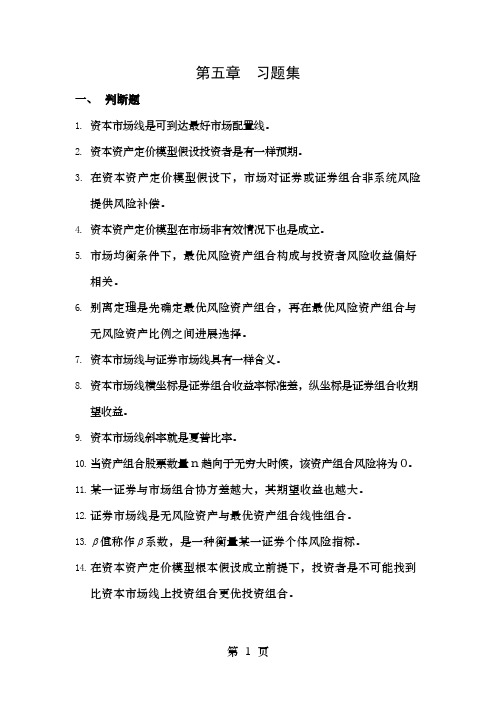
第五章习题集一、判断题1.资本市场线是可到达最好市场配置线。
2.资本资产定价模型假设投资者是有一样预期。
3.在资本资产定价模型假设下,市场对证券或证券组合非系统风险提供风险补偿。
4.资本资产定价模型在市场非有效情况下也是成立。
5.市场均衡条件下,最优风险资产组合构成与投资者风险收益偏好相关。
6.别离定理是先确定最优风险资产组合,再在最优风险资产组合与无风险资产比例之间进展选择。
7.资本市场线与证券市场线具有一样含义。
8.资本市场线横坐标是证券组合收益率标准差,纵坐标是证券组合收期望收益。
9.资本市场线斜率就是夏普比率。
10.当资产组合股票数量n趋向于无穷大时候,该资产组合风险将为0。
11.某一证券与市场组合协方差越大,其期望收益也越大。
12.证券市场线是无风险资产与最优资产组合线性组合。
13.β值称作β系数,是一种衡量某一证券个体风险指标。
14.在资本资产定价模型根本假设成立前提下,投资者是不可能找到比资本市场线上投资组合更优投资组合。
15.证券市场线代表某一证券或证券组合预期收益率与之所承当系统性风险成正比一种关系式。
16.利率风险不属于系统性风险。
17.β系数就是该目标资产与市场组合协方差相对市场组合方差比值。
18.CML与SML都是用均值-方差方法来衡量投资组合预期收益与投资风险。
19.无效组合位于证券市场线上,而有效组合仅位于资本市场线上。
20.特征线方程统计回归中截距项代表是该证券常数收益率。
21.β系数代表是该证券所承当系统性风险。
22.风险就意味着亏损,或者是亏损概率变大。
23.有效组合再组合仍是有效组合。
24.信用风险就是所谓违约风险。
25.随着投资组合中证券数量增加,非系统性风险下降是先慢后快。
26.不同投资者会有不同最优风险资产组合。
27.一般可以认为3年期国债利率就是无风险收益率。
28.无风险资产配置比例高于最优风险资产组合投资者属于风险厌恶型。
29.系统风险是一种可分散风险。
(完整版)投资学第10版习题答案05
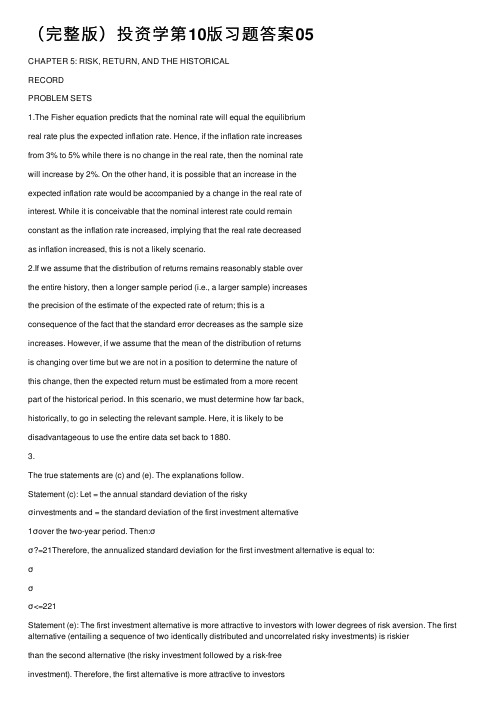
(完整版)投资学第10版习题答案05CHAPTER 5: RISK, RETURN, AND THE HISTORICALRECORDPROBLEM SETS1.The Fisher equation predicts that the nominal rate will equal the equilibriumreal rate plus the expected inflation rate. Hence, if the inflation rate increasesfrom 3% to 5% while there is no change in the real rate, then the nominal ratewill increase by 2%. On the other hand, it is possible that an increase in theexpected inflation rate would be accompanied by a change in the real rate ofinterest. While it is conceivable that the nominal interest rate could remainconstant as the inflation rate increased, implying that the real rate decreasedas inflation increased, this is not a likely scenario.2.If we assume that the distribution of returns remains reasonably stable overthe entire history, then a longer sample period (i.e., a larger sample) increasesthe precision of the estimate of the expected rate of return; this is aconsequence of the fact that the standard error decreases as the sample sizeincreases. However, if we assume that the mean of the distribution of returnsis changing over time but we are not in a position to determine the nature ofthis change, then the expected return must be estimated from a more recentpart of the historical period. In this scenario, we must determine how far back,historically, to go in selecting the relevant sample. Here, it is likely to bedisadvantageous to use the entire data set back to 1880.3.The true statements are (c) and (e). The explanations follow.Statement (c): Let = the annual standard deviation of the riskyσinvestments and = the standard deviation of the first investment alternative1σover the two-year period. Then:σσ?=21Therefore, the annualized standard deviation for the first investment alternative is equal to:σσσ<=221Statement (e): The first investment alternative is more attractive to investors with lower degrees of risk aversion. The first alternative (entailing a sequence of two identically distributed and uncorrelated risky investments) is riskierthan the second alternative (the risky investment followed by a risk-freeinvestment). Therefore, the first alternative is more attractive to investorswith lower degrees of risk aversion. Notice, however, that if you mistakenly believed that time diversification can reduce the total risk of a sequence ofrisky investments, you would have been tempted to conclude that the firstalternative is less risky and therefore more attractive to more risk-averseinvestors. This is clearly not the case; the two-year standard deviation of the first alternative is greater than the two-year standard deviation of the second alternative.4.For the money market fund, your holding-period return for the next yeardepends on the level of 30-day interest rates each month when the fund rolls over maturing securities. The one-year savings deposit offers a 7.5% holding period return for the year. If you forecast that the rate on money marketinstruments will increase significantly above the current 6% yield, then themoney market fund might result in a higher HPR than the savings deposit.The 20-year Treasury bond offers a yield to maturity of 9% per year, which is 150 basis points higher than the rate on the one-year savings deposit;however, you could earn a one-year HPR much less than 7.5% on the bond if long-term interest rates increase during the year. If Treasury bond yields rise above 9%, then the price of the bond will fall, and the resulting capital losswill wipe out some or all of the 9% return you would have earned if bondyields had remained unchanged over the course of the year.5. a.If businesses reduce their capital spending, then they are likely todecrease their demand for funds. This will shift the demand curve inFigure 5.1 to the left and reduce the equilibrium real rate of interest.b.Increased household saving will shift the supply of funds curve to theright and cause real interest rates to fall.c.Open market purchases of U.S. Treasury securities by the FederalReserve Board are equivalent to an increase in the supply of funds (ashift of the supply curve to the right). The FED buys treasuries withcash from its own account or it issues certificates which trade likecash. As a result, there is an increase in the money supply, and theequilibrium real rate of interest will fall.6. a.The “Inflation-Plus” CD is the safer investment because it guarantees thepurchasing power of the investment. Using the approximation that the realrate equals the nominal rate minus the inflation rate, the CD provides a realrate of 1.5% regardless of the inflation rate.b.The expected return depends on the expected rate of inflation over the nextyear. If the expected rate of inflation is less than 3.5% then the conventionalCD offers a higher real return than the inflation-plus CD; if the expected rateof inflation is greater than 3.5%, then the opposite is true.c.If you expect the rate of inflation to be 3% over the next year, then theconventional CD offers you an expected real rate of return of 2%, which is0.5% higher than the real rate on the inflation-protected CD. But unless youknow that inflation will be 3% with certainty, the conventional CD is alsoriskier. The question of which is the better investment then depends on yourattitude towards risk versus return. You might choose to diversify and investpart of your funds in each.d.No. We cannot assume that the entire difference between the risk-freenominal rate (on conventional CDs) of 5% and the real risk-free rate (oninflation-protected CDs) of 1.5% is the expected rate of inflation. Part of thedifference is probably a risk premium associated with the uncertaintysurrounding the real rate of return on the conventional CDs. This impliesthat the expected rate of inflation is less than 3.5% per year.7.E(r) = [0.35 × 44.5%] + [0.30 × 14.0%] + [0.35 × (–16.5%)] = 14%σ2 = [0.35 × (44.5 – 14)2] + [0.30 × (14 – 14)2] + [0.35 × (–16.5 – 14)2] = 651.175σ = 25.52%The mean is unchanged, but the standard deviation has increased, as theprobabilities of the high and low returns have increased.8.Probability distribution of price and one-year holding period return for a 30-year U.S. Treasury bond (which will have 29 years to maturity at year-end):Economy Probability YTM Price CapitalGainCouponInterest HPRBoom0.2011.0%$ 74.05-$25.95$8.00-17.95% Normal growth0.508.0100.00 0.008.008.00Recession0.307.0112.2812.288.0020.289.E(q) = (0 × 0.25) + (1 × 0.25) + (2 × 0.50) = 1.25σq = [0.25 × (0 – 1.25)2 + 0.25 × (1 – 1.25)2 + 0.50 × (2 – 1.25)2]1/2 = 0.8292 10.(a) With probability 0.9544, the value of a normally distributedvariable will fall within 2 standard deviations of the mean; that is,between –40% and 80%. Simply add and subtract 2 standarddeviations to and from the mean.11.From Table 5.4, the average risk premium for the period 7/1926-9/2012 was:12.34% per year.Adding 12.34% to the 3% risk-free interest rate, the expected annual HPR for the Big/Value portfolio is: 3.00% + 12.34% = 15.34%.12.(01/1928-06/1970)Small BigLow2High Low2HighAverage 1.03% 1.21% 1.46%0.78%0.88% 1.18%SD8.55%8.47%10.35% 5.89% 6.91%9.11%Skew 1.6704 1.6673 2.30640.0067 1.6251 1.6348Kurtosis13.150513.528417.2137 6.256416.230513.6729(07/1970-12/2012)Small BigLow2High Low2HighAverage0.91% 1.33% 1.46%0.93% 1.02% 1.13%SD7.00% 5.49% 5.66% 4.81% 4.50% 4.78%Skew-0.3278-0.5135-0.4323-0.3136-0.3508-0.4954Kurtosis 1.7962 3.1917 3.8320 1.8516 2.0756 2.8629No. The distributions from (01/1928–06/1970) and (07/1970–12/2012) periods have distinct characteristics due to systematic shocks to the economy and subsequent government intervention. While the returns from the two periods do not differ greatly, their respective distributions tell a different story. The standard deviation for all six portfolios is larger in the first period. Skew is also positive, but negative in the second, showing a greater likelihood of higher-than-normal returns in the right tail. Kurtosis is also markedly larger in the first period.13.a%88.5,0588.070.170.080.01111or i i rn i rn rr =-=+-=-++=b.rr ≈ rn - i = 80% - 70% = 10%Clearly, the approximation gives a real HPR that is too high.14.From Table 5.2, the average real rate on T-bills has been 0.52%.a.T-bills: 0.52% real rate + 3% inflation = 3.52%b.Expected return on Big/Value:3.52% T-bill rate + 12.34% historical risk premium = 15.86%c.The risk premium on stocks remains unchanged. A premium, thedifference between two rates, is a real value, unaffected by inflation.15.Real interest rates are expected to rise. The investment activity will shiftthe demand for funds curve (in Figure 5.1) to the right. Therefore theequilibrium real interest rate will increase.16. a.Probability distribution of the HPR on the stock market and put:STOCKPUT State of the Economy Probability Ending Price +Dividend HPREnding Value HPR Excellent 0.25$ 131.0031.00%$ 0.00-100%Good 0.45 114.0014.00$ 0.00-100Poor 0.25 93.25?6.75$ 20.2568.75Crash0.05 48.00-52.00$ 64.00433.33Remember that the cost of the index fund is $100 per share, and the costof the put option is $12.b.The cost of one share of the index fund plus a put option is $112. Theprobability distribution of the HPR on the portfolio is:State of the Economy Probability Ending Price +Put +Dividend HPRExcellent 0.25$ 131.0017.0%= (131 - 112)/112Good 0.45 114.00 1.8= (114 - 112)/112Poor 0.25 113.50 1.3= (113.50 - 112)/112Crash0.05 112.000.0= (112 - 112)/112c.Buying the put option guarantees the investor a minimum HPR of 0.0%regardless of what happens to the stock's price. Thus, it offers insuranceagainst a price decline.17.The probability distribution of the dollar return on CD plus call option is:State of theEconomyProbability Ending Value of CD Ending Value of Call Combined Value Excellent0.25$ 114.00$16.50$130.50Good0.45 114.00 0.00114.00Poor0.25 114.00 0.00114.00Crash 0.05 114.00 0.00114.0018.a.Total return of the bond is (100/84.49)-1 = 0.1836. With t = 10, the annual rate on the real bond is (1 + EAR) = = 1.69%.1.18361/10 b.With a per quarter yield of 2%, the annual yield is = 1.0824, or8.24%. The equivalent continuously compounding (cc) rate is ln(1+.0824) =.0792, or 7.92%. The risk-free rate is 3.55% with a cc rate of ln(1+.0355) =.0349, or 3.49%. The cc risk premium will equal .0792 - .0349 = .0443, or4.433%.c.The appropriate formula is , σ2(effective )= e2 × m (cc ) ×[e σ2(cc )1]where . Using solver or goal seek, setting thetarget cell to the known effective cc rate by changing the unknown variance (cc) rate, the equivalent standard deviation (cc) is 18.03% (excel mayyield slightly different solutions).d.The expected value of the excess return will grow by 120 months (12months over a 10-year horizon). Therefore the excess return will be 120 × 4.433% = 531.9%. The expected SD grows by the square root of timeresulting in 18.03% × = 197.5%. The resulting Sharpe ratio is120531.9/197.5 = 2.6929. Normsdist (-2.6929) = .0035, or a .35% probabilityof shortfall over a 10-year horizon.CFA PROBLEMS1.The expected dollar return on the investment in equities is $18,000 (0.6 × $50,000 + 0.4× ?$30,000) compared to the $5,000 expected return for T-bills. Therefore, theexpected risk premium is $13,000.2.E(r) = [0.2 × (?25%)] + [0.3 × 10%] + [0.5 × 24%] =10%3.E(r X) = [0.2 × (?20%)] + [0.5 × 18%] + [0.3 × 50%] =20%E(r Y) = [0.2 × (?15%)] + [0.5 × 20%] + [0.3 × 10%] =10%4.σX2 = [0.2 × (– 20 – 20)2] + [0.5 × (18 – 20)2] + [0.3 × (50 – 20)2] = 592σX = 24.33%σY2 = [0.2 × (– 15 – 10)2] + [0.5 × (20 – 10)2] + [0.3 × (10 – 10)2] = 175σY = 13.23%5.E(r) = (0.9 × 20%) + (0.1 × 10%) =19% $1,900 in returns6.The probability that the economy will be neutral is 0.50, or 50%. Given aneutral economy, the stock will experience poor performance 30% of thetime. The probability of both poor stock performance and a neutral economy is therefore:0.30 × 0.50 = 0.15 = 15%7.E(r) = (0.1 × 15%) + (0.6 × 13%) + (0.3 × 7%) = 11.4%。
投资学第七版ch05课后答案
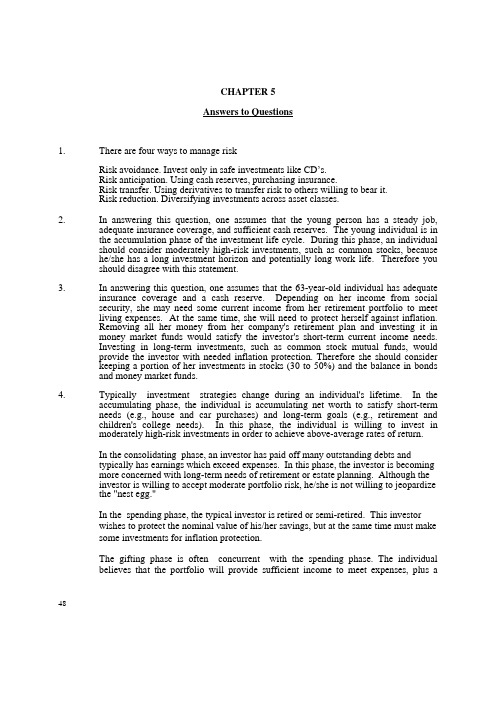
CHAPTER 5Answers to Questions1.There are four ways to manage riskRisk avoidance. Invest only in safe investments like CD’s.Risk anticipation. Using cash reserves, purchasing insurance.Risk transfer. Using derivatives to transfer risk to others willing to bear it.Risk reduction. Diversifying investments across asset classes.2.In answering this question, one assumes that the young person has a steady job,adequate insurance coverage, and sufficient cash reserves. The young individual is inthe accumulation phase of the investment life cycle. During this phase, an individualshould consider moderately high-risk investments, such as common stocks, becausehe/she has a long investment horizon and potentially long work life. Therefore youshould disagree with this statement.3.In answering this question, one assumes that the 63-year-old individual has adequateinsurance coverage and a cash reserve. Depending on her income from socialsecurity, she may need some current income from her retirement portfolio to meetliving expenses. At the same time, she will need to protect herself against inflation.Removing all her money from her company's retirement plan and investing it inmoney market funds would satisfy the investor's short-term current income needs.Investing in long-term investments, such as common stock mutual funds, wouldprovide the investor with needed inflation protection. Therefore she should considerkeeping a portion of her investments in stocks (30 to 50%) and the balance in bondsand money market funds.4.Typically investment strategies change during an individual's lifetime. In theaccumulating phase, the individual is accumulating net worth to satisfy short-termneeds (e.g., house and car purchases) and long-term goals (e.g., retirement andchildren's college needs). In this phase, the individual is willing to invest inmoderately high-risk investments in order to achieve above-average rates of return.In the consolidating phase, an investor has paid off many outstanding debts andtypically has earnings which exceed expenses. In this phase, the investor is becomingmore concerned with long-term needs of retirement or estate planning. Although theinvestor is willing to accept moderate portfolio risk, he/she is not willing to jeopardizethe "nest egg."In the spending phase, the typical investor is retired or semi-retired. This investorwishes to protect the nominal value of his/her savings, but at the same time must makesome investments for inflation protection.The gifting phase is often concurrent with the spending phase. The individualbelieves that the portfolio will provide sufficient income to meet expenses, plus a48reserve for uncertainties. If an investor believes there are excess amounts available inthe portfolio, he/she may decide to make "gifts" to family or friends, institutecharitable trusts, or establish trusts to minimize estate taxes.5. A policy statement is important for both the investor and the investment advisor. Apolicy statement assists the investor in establishing realistic investment goals,assessing constraints (liquidity, time horizon, tax effects etc.) as well as, providing abenchmark by which a portfolio manager's performance may be measured.Exercise6.Student7.The 45-year old uncle and 35-year old sister differ in terms of time horizon. However,each has some time before retirement (20 versus 30 years). Each should have asubstantial proportion of his/her portfolio invested in equities, with the 35-year oldsister possibly having more equity investments in small firms or international firms(i.e., can tolerate greater portfolio risk). These investors could also differ in currentliquidity needs (such as children, education expenses, etc.), tax concerns, and/or otherunique needs or preferences.8.Before constructing an investment policy statement, the financial planner needs toclarify the client's investment objectives (e.g. capital preservation, capitalappreciation, current income or total return) and constraints (e.g. liquidity needs, timehorizon, tax factors, legal and regulatory constraints, and unique needs andpreferences).9.CFA Examination IIIa) At this point we know (or can reasonably infer) thatMr. Franklin is:•unmarried (a recent widower) and childless•70 years of age•in good health•possesses a large amount of (relatively) liquid wealth and intends to leave his estate to a tax-exempt medical research foundation, to whom he is also giving a large currentcash gift•free of debt (not explicitly stated, but neither is the opposite)•in the highest tax brackets (not explicitly stated, but apparent)•not skilled in the management of a large investment portfolio, but also not a complete novice since he owned significant assets of his own prior to his wife's death •not burdened by large or specific needs for current income•not in need of large or specific amounts of current liquidityBased on this information, an appropriate Investment Policy Statement would be: Objectives:Return Requirements: The incidental throw-off of income from Mr. Franklin's large asseta need can easily be met by minor portfolio adjustments. Thus, an inflation-adjustedenhancement of the capital base for the benefit of the foundation will be the primary49return goal (i.e., real growth of capital). Tax minimization will be a continuingcollateral goal.Risk Tolerance: Account circumstances and the long-term return goal suggest that the nature of investment risk from his prior ownership of stocks and bonds, he has a stilllong actuarial life expectancy and is in good current health, and his heir-thefoundation, thanks to his generosity-is already possessed of a large asset base.Constraints:Time Horizon: Even disregarding Mr. Franklin's still-long actuarial life expectancy, the horizon is long-term because the remainder of his estate, the foundation, has avirtually perpetual life span.Liquidity Requirement: Given what we know and the expectation of an ongoing income stream of considerable size, no liquidity needs that would require specific fundingappear to exist.Taxes: Mr. Franklin is no doubt in the highest tax brackets, and investment actions should take that fact into account on a continuing basis. Appropriate tax-sheltered investment(standing on their own merits as investments) should be considered. Tax minimizationwill be a specific investment goal.Legal and Regulatory: Investments, if under the supervision of an investment management Prudent Person rule.Unique Circumstances: The large asset total, the foundation as their ultimate recipient, and considerations) are important in this situation, if not necessarily unique.(b) Given that stocks have provided (and are expected to continue to provide) higherrisk adjusted returns than either bonds or cash, and considering that the return goal isfor long-term, inflation-protected growth of the capital base, stocks will be allotted themajority position in the portfolio. This is also consistent with Mr. Franklin's absenceof either specific current income needs (the ongoing cash flow should provide anadequate level for current spending) or specific liquidity needs. It is likely that incomewill accumulate to some extent and, if so, will automatically build a liquid emergencyfund for Mr. Franklin as time passes.Since the inherited warehouse and the personal residence are significant (15%) realestate assets already owned by Mr. Franklin, no further allocations to this asset class ismade. It should be noted that the warehouse is a source of cash flow, a diversifyingasset and, probably, a modest inflation hedge. For tax reasons, Mr. Franklin may wishto consider putting some debt on this asset, freeing additional cash for alternativeinvestment use.50Given the long-term orientation and the above-average risk tolerance in this situation, about 70% of total assets can be allocated to equities (including real estate)and about 30% to fixed income assets. International securities will be included in bothareas, primarily for their diversification benefits. Municipal bonds will be included inthe fixed income area to minimize income taxes. There is no need to press for yield inthis situation, nor any need to deliberately downgrade the quality of the issues utilized.Venture capital investment can be considered, but any commitment to this (or other"alternative" assets) should be kept small.The following is one example of an appropriate allocation that is consistent with the Investment Policy Statement and consistent with the historical and expected returnand other characteristics of the various available asset classes:CurrentRange TargetCash/Money Market 0 - 5% 0%U.S. Fixed Income 10 - 20 15Non-U.S. Fixed Income 5 - 15 10U.S. Stocks (Large Cap) 30 - 45 30(Small Cap) 15 - 25 15Non-U.S. Stocks 15 - 25 15Real Estate 10 - 15 15*Other 0 - 5 0100%*Includes the Franklin residence and warehouse, which together comprise the proportion of total assets shown.An alternate allocation could well be weighted more heavily to U.S. fixed income and less so to U.S. stocks, given the near equality of expected returns from those assets asindicated in Table 4.51CHAPTER 5Answers to Problems1.Most experts recommend that about 6 month's worth of living expenses be held incash reserves. Although these funds are identified as "cash," it is recommended thatthey be invested in instruments that can easily be converted to cash with little chanceof loss in value (e.g., money market mutual funds, etc.).Most experts recommend that an individual should carry life insurance equal to 7-10times an individual's annual salary. An unmarried individual should have coverageequal to at least 7 times salary, whereas a married individual with two children shouldhave more coverage (possibly 9-10 times salary).2. Married, filing jointly, $20,000 taxable income:Marginal tax rate = 15%Taxes due = 1,400 + (0.15)(20,000 – 14,000) = $2,300Average tax rate = 2,300/20,000 = 11.5%Married, filing jointly, $40,000 taxable income:Marginal tax rate = 15%Taxes due = 1,400 + (0.15)(40,000 – 14,000) = $5,300Average tax rate =5,300/40,000 = 13.25%Married, filing jointly, $60,000 taxable income:Marginal tax rate = 25%Taxes due = $7,820 + (0.25)($60,000 - $56,800) = $8,620verage tax rate = 8,620/60,000 = 14.37%3. Single with $20,000 taxable income:Marginal tax rate = 15%Taxes due = 700 + (0.15)(20,000 – 7,000) = $2,650Average tax rate = 2,650/20,000 = 13.25%Single with $40,000 taxable income:Marginal tax rate = 25%Taxes due = $3,910 + (0.25)(40,000 - 28,400) = $6,810Average tax rate = 6,810/40,000 = 17.03%Single with $60,000 taxable income:Marginal tax rate = 25%Taxes due = $3,910 + (0.25)(60,000 - 28,400) = $11,810Average tax rate = 11,810/60,000 = 19.68%4.(a). $10,000 invest in 9 percent tax-exempt IRA (assuming annual compounding)In 5 years: $10,000(1 + 0.09)5 = $15,386In 10 years: $10,000(1 + 0.09)10 = $23,67452In 20 years: $10,000(1 + 0.09)20 = $56,044(b). After-tax yield = Before-tax yield (1 - Tax rate)= 0.09(1 - 0.36)= 0.0576 or 5.76%$10,000 invest at 5.76 percent (assuming annual compounding)In 5 years: $10,000(1 + 0.0576)5 = $13,231In 10 years: $10,000(1 + 0.0576)10 = $17,507In 20 years: $10,000(1 + 0.0576)20 = $30,6505.(a). $10,000 invest in 10 percent tax-exempt IRA (assuming annual compounding)In 5 years: $10,000(1 + 0.10)5 = $16,105In 10 years: $10,000(1 + 0.10)10 = $25,937In 20 years: $10,000(1 + 0.10)20 = $67,275(b). After-tax yield = Before-tax yield (1 - Tax rate)= 0.10(1 - .15)= 0.085 or 8.50%$10,000 invest at 8.50 percent (assuming annual compounding)In 5 years: $10,000(1 + 0.10)5 = $15,037In 10 years: $10,000(1 + 0.10)10 = $22,610In 20 years: $10,000(1 + 0.10)20 = $51,12053Chapter 5Answers to Spreadsheet Exercises1.(a)Amount Interest Time FV2000 0.08 10 $4,317.855000 0.075 20 $21,239.2610000 0.1 25 $108,347.06(b)Amount Interest Time FV1000 0.1 20 $57,275.002000 0.06 15 $46,551.945000 0.085 25 $393,338.96(c)FV Interest Time Savings100000 0.07 17 $3,242.521000000 0.09 35 $4,635.84500000 0.11 25 $4,370.122.RegularIRAIRA Roth5000.00Contribution 5000.00Tax savings 1250.00 0.00Total Invested 6250.00 5000.00Current tax rate 0.25 0.25Tax rate at0.15retirement 0.15Time Horizon 25.00 25.000.12Rate 0.12FV Contribution 88877.42 88877.42FV Tax savings 11155.87Total Pre tax 100033.29Total after tax 86701.68 88877.42Retirement tax rate = 10%. After 25 years Regular IRA = $91,146. Roth IRA = $88,877Retirement tax rate = 15%. After 25 years Regular IRA = $86,702. Roth IRA = $88,87754Retirement tax rate = 25%. After 25 years Regular IRA = $77,814. Roth IRA = $88,877Retirement tax rate = 28%. After 25 years Regular IRA = $75,148. Roth IRA = $88,877Retirement tax rate = 33%. After 25 years Regular IRA = $77,704. Roth IRA = $88,8773. Student Exercise4.Interest rate 6%Withdrawalrate 8%Year PrincipaloutflowBalance0 $500,000.0$40,000.0$460,000.01 $487,600.0$39,008.0$448,592.02 $475,507.52$38,040.6$437,466.923 $463,714.93$37,097.19$426,617.744 $452,214.8$36,177.18$416,037.625 $440,999.88$35,279.99$405,719.896 $430,063.08$34,405.05$395,658.037 $419,397.51$33,551.8$385,845.718 $408,996.46$32,719.72$376,276.749 $398,853.34$31,908.27$366,945.0810 $388,961.78$31,116.94$357,844.8411 $379,315.53$30,345.24$348,970.2912 $369,908.5$29,592.68$340,315.82135556$360,734.77 $28,858.78 $331,875.99 14$351,788.55 $28,143.08$323,645.47 15$343,064.19 $27,445.14$315,619.06 16$334,556.20 $26,764.5$307,791.71 17$326,259.21 $26,100.74$300,158.47 18$318,167.98 $25,453.44$292,714.54 19$310,277.41 $24,822.19$285,455.22 20$302,582.53 $24,206.6$278,375.93 21$295,078.49 $23,606.28$271,472.21 22$287,760.54 $23,020.84$264,739.70 23$280,624.08 $22,449.93$258,174.15 24$273,664.60 $21,893.17$251,771.43 25$266,877.72 $21,350.22$245,527.55.Assume immediate loss of15%Interest rate 6% Withdrawal rate 8%Year PrincipaloutflowBalance 0 $500,000.00 $40,000.00$391,000.001 $414,460.00 $33,156.80$381,303.2572 $404,181.39 $32,334.51$371,846.883 $394,157.69 $31,532.62$362,625.084 $384,382.58 $30,750.61$353,631.98 5 $374,849.89 $29,987.99$344,861.90 6 $365,553.62 $29,244.29$336,309.33 7 $356,487.89 $28,519.03$327,968.868 $347,646.99 $27,811.76$319,835.239 $339,025.34 $27,122.03$311,903.3210 $330,617.51 $26,449.40$304,168.1111 $322,418.20 $25,793.46$296,624.74 12 $314,422.23 $25,153.78$289,268.45 13 $306,624.56 $24,529.96$282,094.59 14 $299,020.27 $23,921.62$275,098.65 15 $291,604.57 $23,328.37$268,276.216 $284,372.77 $22,749.82$261,622.9517 $277,320.33 $22,185.63$255,134.70 18 $270,442.78 $21,635.42$248,807.36 19 $263,735.80 $21,098.86$242,636.9584 20 $257,195.15 $20,575.61$236,619.5421 $250,816.71 $20,065.34$230,751.38 22 $244,596.46 $19,567.72$225,028.74 23 $238,530.47 $19,082.44$219,448.03 24 $232,614.91 $18,609.19$214,005.7225 $226,846.06 $18,147.68$208,698.386.Cap. Gain Incom eTotal TotalCap. Gain Income after tax after tax after tax beforetaxInitial Investment $ 10,000 Stocks 50% $ 5,000 8.00% 2.00% 6.56% 1.50% 8.06% 10.00%Bonds 50% $ 5,000 7.00% 5.25% 5.25% 7.00% Tax on CG 18% Tax on income25%Time 10 20 30 FV Stocks (taxable) $10,854.75 $23,565.10 $51,158.63FV Stocks (tax def) $12,968.71 $33,637.50 $87,247.01FV Stocks after tax $10,634.34 $27,582.75 $71,542.55FV Bonds (taxable) $8,340.48 $13,912.72 $23,207.76FV Bonds (tax def) $9,835.76 $19,348.42 $38,061.28FV Bonds after tax $8,065.32 $15,865.71 $31,210.25For longer time horizons you are better off putting stocks and bonds in the tax deferred account.59。
(完整版)投资学第10版习题答案05

CHAPTER 5: RISK, RETURN, AND THE HISTORICALRECORDPROBLEM SETS1. The Fisher equation predicts that the nominal rate will equal the equilibriumreal rate plus the expected inflation rate. Hence, if the inflation rate increasesfrom 3% to 5% while there is no change in the real rate, then the nominal ratewill increase by 2%. On the other hand, it is possible that an increase in theexpected inflation rate would be accompanied by a change in the real rate ofinterest. While it is conceivable that the nominal interest rate could remainconstant as the inflation rate increased, implying that the real rate decreasedas inflation increased, this is not a likely scenario.2. If we assume that the distribution of returns remains reasonably stable overthe entire history, then a longer sample period (i.e., a larger sample) increasesthe precision of the estimate of the expected rate of return; this is aconsequence of the fact that the standard error decreases as the sample sizeincreases. However, if we assume that the mean of the distribution of returnsis changing over time but we are not in a position to determine the nature ofthis change, then the expected return must be estimated from a more recentpart of the historical period. In this scenario, we must determine how far back,historically, to go in selecting the relevant sample. Here, it is likely to bedisadvantageous to use the entire data set back to 1880.3. The true statements are (c) and (e). The explanations follow.Statement (c): Let σ = the annual standard deviation of the risky investmentsand 1σ= the standard deviation of the first investment alternative over the two-year period. Then:σσ⨯=21Therefore, the annualized standard deviation for the first investment alternative is equal to:σσσ<=221Statement (e): The first investment alternative is more attractive to investors with lower degrees of risk aversion. The first alternative (entailing a sequence of two identically distributed and uncorrelated risky investments) is riskierthan the second alternative (the risky investment followed by a risk-freeinvestment). Therefore, the first alternative is more attractive to investors with lower degrees of risk aversion. Notice, however, that if you mistakenlybelieved that time diversification can reduce the total risk of a sequence ofrisky investments, you would have been tempted to conclude that the firstalternative is less risky and therefore more attractive to more risk-averseinvestors. This is clearly not the case; the two-year standard deviation of thefirst alternative is greater than the two-year standard deviation of the secondalternative.4. For the money market fund, your holding-period return for the next yeardepends on the level of 30-day interest rates each month when the fund rolls over maturing securities. The one-year savings deposit offers a 7.5% holding period return for the year. If you forecast that the rate on money marketinstruments will increase significantly above the current 6% yield, then themoney market fund might result in a higher HPR than the savings deposit.The 20-year Treasury bond offers a yield to maturity of 9% per year, which is 150 basis points higher than the rate on the one-year savings deposit; however, you could earn a one-year HPR much less than 7.5% on the bond if long-term interest rates increase during the year. If Treasury bond yields rise above 9%, then the price of the bond will fall, and the resulting capital loss will wipe out some or all of the 9% return you would have earned if bond yields hadremained unchanged over the course of the year.5. a. If businesses reduce their capital spending, then they are likely todecrease their demand for funds. This will shift the demand curve inFigure 5.1 to the left and reduce the equilibrium real rate of interest.b. Increased household saving will shift the supply of funds curve to theright and cause real interest rates to fall.c. Open market purchases of U.S. Treasury securities by the FederalReserve Board are equivalent to an increase in the supply of funds (ashift of the supply curve to the right). The FED buys treasuries withcash from its own account or it issues certificates which trade likecash. As a result, there is an increase in the money supply, and theequilibrium real rate of interest will fall.6. a. The “Inflation-Plus” CD is the safer investment because it guarantees thepurchasing power of the investment. Using the approximation that the realrate equals the nominal rate minus the inflation rate, the CD provides a realrate of 1.5% regardless of the inflation rate.b. The expected return depends on the expected rate of inflation over the nextyear. If the expected rate of inflation is less than 3.5% then the conventionalCD offers a higher real return than the inflation-plus CD; if the expected rateof inflation is greater than 3.5%, then the opposite is true.c. If you expect the rate of inflation to be 3% over the next year, then theconventional CD offers you an expected real rate of return of 2%, which is0.5% higher than the real rate on the inflation-protected CD. But unless youknow that inflation will be 3% with certainty, the conventional CD is alsoriskier. The question of which is the better investment then depends on yourattitude towards risk versus return. You might choose to diversify and investpart of your funds in each.d. No. We cannot assume that the entire difference between the risk-freenominal rate (on conventional CDs) of 5% and the real risk-free rate (oninflation-protected CDs) of 1.5% is the expected rate of inflation. Part of thedifference is probably a risk premium associated with the uncertaintysurrounding the real rate of return on the conventional CDs. This impliesthat the expected rate of inflation is less than 3.5% per year.7. E(r) = [0.35 × 44.5%] + [0.30 × 14.0%] + [0.35 × (–16.5%)] = 14%σ2 = [0.35 × (44.5 – 14)2] + [0.30 × (14 – 14)2] + [0.35 × (–16.5 – 14)2] = 651.175 σ = 25.52%The mean is unchanged, but the standard deviation has increased, as theprobabilities of the high and low returns have increased.8. Probability distribution of price and one-year holding period return for a 30-year U.S. Treasury bond (which will have 29 years to maturity at year-end):Economy Probability YTM Price CapitalGainCouponInterest HPRBoom 0.20 11.0% $ 74.05 -$25.95 $8.00 -17.95% Normal growth 0.50 8.0 100.00 0.00 8.00 8.00 Recession 0.30 7.0 112.28 12.28 8.00 20.289. E(q) = (0 × 0.25) + (1 × 0.25) + (2 × 0.50) = 1.25σq = [0.25 × (0 – 1.25)2 + 0.25 × (1 – 1.25)2 + 0.50 × (2 – 1.25)2]1/2 = 0.8292 10. (a) With probability 0.9544, the value of a normally distributedvariable will fall within 2 standard deviations of the mean; that is,between –40% and 80%. Simply add and subtract 2 standarddeviations to and from the mean.11. From Table 5.4, the average risk premium for the period 7/1926-9/2012 was:12.34% per year.Adding 12.34% to the 3% risk-free interest rate, the expected annual HPR for the Big/Value portfolio is: 3.00% + 12.34% = 15.34%.No. The distributions from (01/1928–06/1970) and (07/1970–12/2012) periods have distinct characteristics due to systematic shocks to the economy and subsequent government intervention. While the returns from the two periods do not differ greatly, their respective distributions tell a different story. The standard deviation for all six portfolios is larger in the first period. Skew is also positive, but negative in the second, showing a greater likelihood of higher-than-normal returns in the right tail. Kurtosis is also markedly larger in the first period.13. a%88.5,0588.070.170.080.01111or i i rn i rn rr =-=+-=-++=b. rr ≈ rn - i = 80% - 70% = 10%Clearly, the approximation gives a real HPR that is too high.14. From Table 5.2, the average real rate on T-bills has been 0.52%.a. T-bills: 0.52% real rate + 3% inflation = 3.52%b. Expected return on Big/Value:3.52% T-bill rate + 12.34% historical risk premium = 15.86%c. The risk premium on stocks remains unchanged. A premium, thedifference between two rates, is a real value, unaffected by inflation.15. Real interest rates are expected to rise. The investment activity will shiftthe demand for funds curve (in Figure 5.1) to the right. Therefore theequilibrium real interest rate will increase.16. a. Probability distribution of the HPR on the stock market and put:STOCK PUT State of theEconomyProbability Ending Price + Dividend HPR Ending Value HPR Excellent0.25 $ 131.00 31.00% $ 0.00 -100% Good0.45 114.00 14.00 $ 0.00 -100 Poor0.25 93.25 −6.75 $ 20.25 68.75 Crash 0.05 48.00 -52.00 $ 64.00 433.33Remember that the cost of the index fund is $100 per share, and the costof the put option is $12.b. The cost of one share of the index fund plus a put option is $112. Theprobability distribution of the HPR on the portfolio is:State of the Economy Probability Ending Price + Put + DividendHPRExcellent 0.25 $ 131.00 17.0%= (131 - 112)/112 Good 0.45 114.00 1.8= (114 - 112)/112 Poor 0.25 113.50 1.3= (113.50 - 112)/112 Crash0.05 112.00 0.0 = (112 - 112)/112 c. Buying the put option guarantees the investor a minimum HPR of 0.0%regardless of what happens to the stock's price. Thus, it offers insuranceagainst a price decline.17. The probability distribution of the dollar return on CD plus call option is:State of theEconomy Probability Ending Valueof CDEnding Valueof CallCombinedValueExcellent 0.25 $ 114.00 $16.50 $130.50Good 0.45 114.00 0.00 114.00Poor 0.25 114.00 0.00 114.00Crash 0.05 114.00 0.00 114.0018.a.Total return of the bond is (100/84.49)-1 = 0.1836. With t = 10, the annualrate on the real bond is (1 + EAR) = = 1.69%.b.With a per quarter yield of 2%, the annual yield is = 1.0824, or8.24%. The equivalent continuously compounding (cc) rate is ln(1+.0824)= .0792, or 7.92%. The risk-free rate is 3.55% with a cc rate of ln(1+.0355)= .0349, or 3.49%. The cc risk premium will equal .0792 - .0349 = .0443, or4.433%.c.The appropriate formula is ,where . Using solver or goal seek, setting thetarget cell to the known effective cc rate by changing the unknown variance(cc) rate, the equivalent standard deviation (cc) is 18.03% (excel mayyield slightly different solutions).d.The expected value of the excess return will grow by 120 months (12months over a 10-year horizon). Therefore the excess return will be 120 ×4.433% = 531.9%. The expected SD grows by the square root of timeresulting in 18.03% × = 197.5%. The resulting Sharpe ratio is531.9/197.5 = 2.6929. Normsdist (-2.6929) = .0035, or a .35% probabilityof shortfall over a 10-year horizon.CFA PROBLEMS1. The expected dollar return on the investment in equities is $18,000 (0.6 × $50,000 + 0.4×−$30,000) compared to the $5,000 expected return for T-bills. Therefore, theexpected risk premium is $13,000.2. E(r) = [0.2 × (−25%)] + [0.3 × 10%] + [0.5 × 24%] =10%3. E(r X) = [0.2 × (−20%)] + [0.5 × 18%] + [0.3 × 50%] =20%E(r Y) = [0.2 × (−15%)] + [0.5 × 20%] + [0.3 × 10%] =10%4. σX2 = [0.2 × (– 20 – 20)2] + [0.5 × (18 – 20)2] + [0.3 × (50 – 20)2] = 592σX = 24.33%σY2 = [0.2 × (– 15 – 10)2] + [0.5 × (20 – 10)2] + [0.3 × (10 – 10)2] = 175σY = 13.23%5. E(r) = (0.9 × 20%) + (0.1 × 10%) =19% $1,900 in returns6. The probability that the economy will be neutral is 0.50, or 50%. Given aneutral economy, the stock will experience poor performance 30% of thetime. The probability of both poor stock performance and a neutral economy is therefore:0.30 × 0.50 = 0.15 = 15%7. E(r) = (0.1 × 15%) + (0.6 × 13%) + (0.3 × 7%) = 11.4%。
威廉夏普_投资学课后习题答案解析第五章
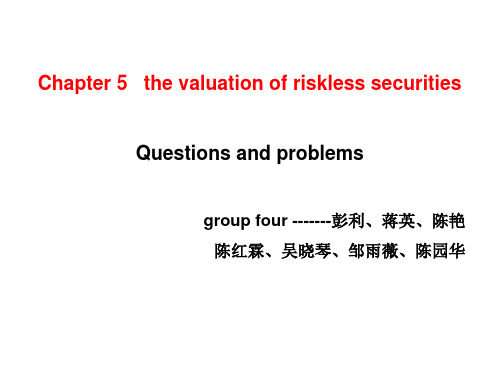
持有期期末价值与期初价值之比:
V3 V1 V2 V3 V0 V0 V1 V2 10800 10600 10200 10300 10100 9900 1.1337
rhp
Value at the end of the holding period Value at the beginning of the holding period
Step2: how many bonds you can buy at the end of the second year ?
You can use the $748.51 to buy: $748.51/$9900 =0.0756
第三年末收到的利息= (1.0693+0.0756)*700=$801.43 第三年末持有的债券的价值:= (1.0693+0.0756)*9500 = $10876.55
-1
=1.1337-1=13.37%
方法二:直接计算出债券在持有期期末的价值。
Step1: how many bonds you can buy at the end of the first year ? You can use the $700 to buy : $700/$10100= 0.0693
批注本地保存成功开通会员云端永久保存去开通
Chapter 5 the valuation of riskless securities
Questions and problems
group four -------彭利、蒋英、陈艳 陈红霖、吴晓琴、邹雨薇、陈园华
4、Face value = $1000
100 100 1100 997.18 2 1 s1 (1 s 2 ) (1 s3 ) 3 997.18 100d1 100d 2 1100 3 d d 3 0.749
投资学基础答案

投资学基础答案【篇一:《投资学》课后习题参考答案】2章答案:一、选择1、d2、c 二、填空1、公众投资者、工商企业投资者、政府2、中国人民保险公司;中国国际信托投资公司 3、威尼斯、英格兰4、信用合作社、合作银行;农村信用合作社、城市信用合作社;5、安全性、流动性、效益性三、名词解释:财务公司又称金融公司,是一种经营部分银行业务的非银行金融机构。
其最初是为产业集团内部各分公司筹资,便利集团内部资金融通,但现在经营领域不断扩大,种类不断增加,有的专门经营抵押放款业务,有的专门经营耐用消费品的租购和分期付款业务,大的财务公司还兼营外汇、联合贷款、包销证券、不动产抵押、财务及投资咨询服务等。
信托公司是指以代人理财为主要经营内容、以委托人身份经营现代信托业务的金融机构。
信托公司的业务一般包括货币信托(信托贷款、信托存款、养老金信托、有价证券投资信托等)和非货币信托(债权信托、不动产信托、动产信托等)两大类。
保险公司是一类经营保险业务的金融中介机构。
它以集合多数单位或个人的风险为前提,用其概率计算分摊金,以保险费的形式聚集资金建立保险基金,用于补偿因自然灾害或以外事故造成的经济损失,或对个人因死亡伤残给予物质补偿。
四、简答1、家庭个人是金融市场上的主要资金供应者,其呈现出的主要特点如下:(1)投资目标简单;(2)投资活动更具盲目性(3)投资规模较小,投资方向分散,投资形式灵活。
企业作为非金融投资机构,其行为呈现出了以下的显著特点:(1)资金需求者地位突现;(2)投资目标的多元化;(3)投资比较稳定;(4)短期投资交易量大。
2、商业银行在经济运行中主要的职能如下:(1)信用中介职能;(2)支付中介职能;(3)调节媒介职能;(4)金融服务职能;(5)信用创造职能;总的来说,商业银行业务可以归为以下三类:(1)负债业务:是指资金来源的业务;(2)资产业务:是商业银行运用资金的业务;(3)中间业务和表外业务:中间业务指银行不需要运用自己的资金而代客户承办支付和其他委托事项,并据以收取手续费的业务第3章答案:一、选择题1、d2、d3、b 二、填空题1、会员制证券交易所和公司制证券交易所、会员制、公司制。
博迪《投资学》(第9版)课后习题-风险与收益入门及历史回顾(圣才出品)
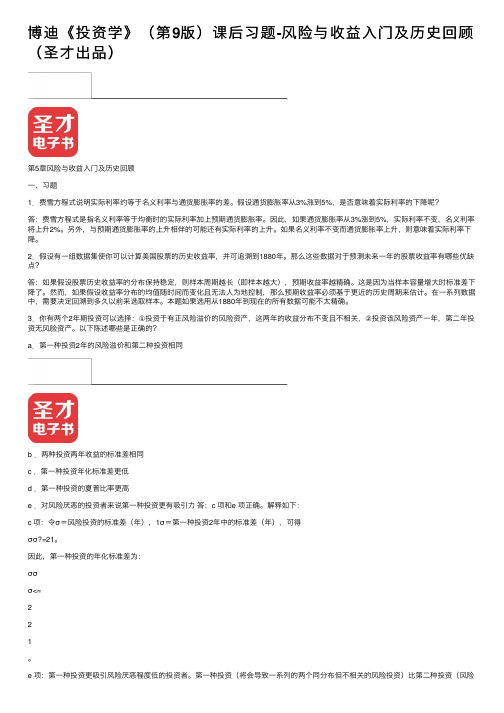
博迪《投资学》(第9版)课后习题-风险与收益⼊门及历史回顾(圣才出品)第5章风险与收益⼊门及历史回顾⼀、习题1.费雪⽅程式说明实际利率约等于名义利率与通货膨胀率的差。
假设通货膨胀率从3%涨到5%,是否意味着实际利率的下降呢?答:费雪⽅程式是指名义利率等于均衡时的实际利率加上预期通货膨胀率。
因此,如果通货膨胀率从3%涨到5%,实际利率不变,名义利率将上升2%。
另外,与预期通货膨胀率的上升相伴的可能还有实际利率的上升。
如果名义利率不变⽽通货膨胀率上升,则意味着实际利率下降。
2.假设有⼀组数据集使你可以计算美国股票的历史收益率,并可追溯到1880年。
那么这些数据对于预测未来⼀年的股票收益率有哪些优缺点?答:如果假设股票历史收益率的分布保持稳定,则样本周期越长(即样本越⼤),预期收益率越精确。
这是因为当样本容量增⼤时标准差下降了。
然⽽,如果假设收益率分布的均值随时间⽽变化且⽆法⼈为地控制,那么预期收益率必须基于更近的历史周期来估计。
在⼀系列数据中,需要决定回溯到多久以前来选取样本。
本题如果选⽤从1880年到现在的所有数据可能不太精确。
3.你有两个2年期投资可以选择:①投资于有正风险溢价的风险资产,这两年的收益分布不变且不相关,②投资该风险资产⼀年,第⼆年投资⽆风脸资产。
以下陈述哪些是正确的?a.第⼀种投资2年的风险溢价和第⼆种投资相同b .两种投资两年收益的标准差相同c .第⼀种投资年化标准差更低d .第⼀种投资的夏普⽐率更⾼e .对风险厌恶的投资者来说第⼀种投资更有吸引⼒答:c 项和e 项正确。
解释如下:c 项:令σ=风险投资的标准差(年),1σ=第⼀种投资2年中的标准差(年),可得σσ?=21。
因此,第⼀种投资的年化标准差为:σσσ<=221。
e 项:第⼀种投资更吸引风险厌恶程度低的投资者。
第⼀种投资(将会导致⼀系列的两个同分布但不相关的风险投资)⽐第⼆种投资(风险投资后跟着⼀个⽆风险投资)风险更⼤。
- 1、下载文档前请自行甄别文档内容的完整性,平台不提供额外的编辑、内容补充、找答案等附加服务。
- 2、"仅部分预览"的文档,不可在线预览部分如存在完整性等问题,可反馈申请退款(可完整预览的文档不适用该条件!)。
- 3、如文档侵犯您的权益,请联系客服反馈,我们会尽快为您处理(人工客服工作时间:9:00-18:30)。
1.根据交易者的信息结构,可以把交易者分为知情交易者和非知情交易者。
知情交易者拥有关于资产价值的私人信息,这些私人信息不为知情交易者以外的其他市场参与者。
非知情交易者没有关于资产价值的私人信息,他们交易的动机是出于流动性的需要而非获取资产的未来收益。
于是非知情交易者又称为流动性交易者。
知情交易者拥有关于资产价值的私人信息,在市场上拥有垄断优势。
因此知情交易者可以利用自己的信息优势制定最优的交易策略来获取垄断收益。
非知情交易者分为相机抉择和非相机抉择两种。
前者通过对交易时间的选择制定最优的交易策略,从而是自己的损失降至最低。
后者只能在给定的时刻交易某个特定数量的资产,只能被动地进行交易。
这种差别的原因,主要在于是否拥有私人信息。
2. 知情交易者的交易策略与做市商的定价策略都是线性的,而且做市商的定价策略是被动的,公开的。
知情交易者可以很好的预测,自己下了一定数量的订单之后,做市商的反应。
因此,这场贯序博弈中,知情交易者具有先动优势。
不存在其他均衡,因为将做市商的定价策略代入知情交易者的交易策略函数之后,得到一个二次函数,这一函数的极大值是唯一的。
